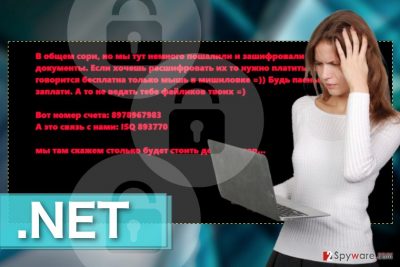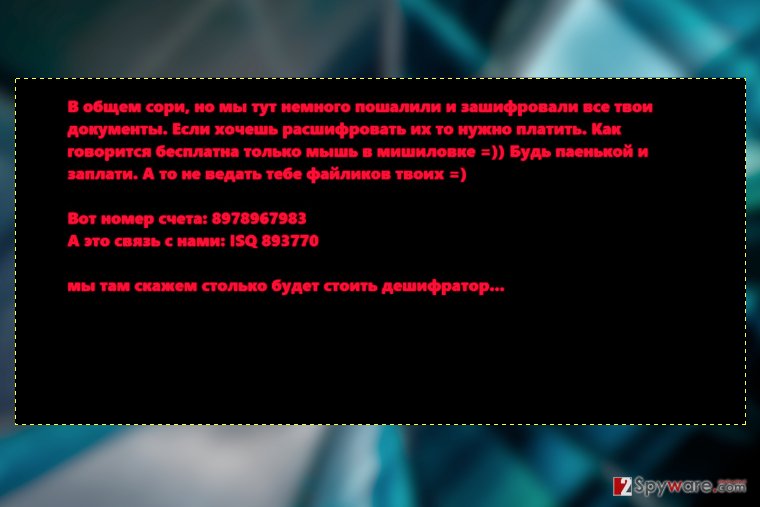.NET ransomware / virus (Removal Guide) - Recovery Instructions Included
.NET virus Removal Guide
What is .NET ransomware virus?
CryptoWall-related .NET ransomware targets Russian-speaking users
.NET virus is a new crypto-ransomware [1] thought to be a follow-up version of the infamous and widespread CryptoWall virus family. Looking at its ransom note that is written in Russian it is quite obvious that the virus was at least primarily oriented towards the Russian-speaking users. Of course, ransomware spread easily, so everyone should keep their computers carefully guarded. What led experts to associate this malware with CryptoWall was the title of its executable which plain and simply states — CryptoWall.exe. But there are also reports about 7865.exe file also being used to encrypt the infected system. Regardless of what executable carry the malicious, when it is executed it will start scanning the computer for files and append them with .wtdi extensions. “If you want to recover your files — you must pay.” That’s basically all that the extortionists want the victims to understand from the brief ransom note they leave on the infected computer. The message contains a number of the victim’s account and a number for “ISQ” communication [2]. The rest of the details such as the ransom size and the payment method are only revealed after contacting the hackers directly. Luckily, a closer investigation of the program’s source code revealed that this malware is actually decryptable and there is really no need to give your money away to the criminals who may not even explain how to recover your files after all. While the free decryptor is on its way, you should take care of the .NET removal. We suggest using tools such as FortectIntego to complete the process quicker.

Even after some breakthroughs in its decryption, .NET ransomware remains a rather mysterious malware. Experts are not sure whether this parasite is a new and sloppy version of the real CryptoWall or a creation of a completely unrelated group of hackers who only use the name of this widely-dreaded threat to freak people out and swindle away their money. Either way, it’s best to keep away from this parasite and create backup copies of your files in case the criminals upgrade the malware making it undecryptable.

Preventing ransomware infiltration
If you want to prevent .NET virus from unexpectedly turning up on your system, you must look after your computer. The care consists of regularly updating installed software and operating system, obtaining a reliable antivirus utility and keeping backup copies of your files stored somewhere safe, ideally, on a separate hard drive or USB device. OF course, you should also keep in mind that .NET virus may employ deceptive techniques such as fake ads to sneak into your computer. Don’t blindly download software that might you might be prompted on random websites and download software updates from the official sources ONLY. These safety precautions should diminish the risk of ransomware infection.
Don’t wait — remove .NET following guidelines below:
.NET removal may seem like a challenging task and in some cases, it may be one. In fact, it may end up in complete corruption of the operating system if not carried out correctly. Do not try to remove. NET manually — it will most likely cause more harm than benefit. Instead, employ antivirus software such as FortectIntego to scan your entire system, remove the virus and clean up the malicious Registry entries. After you are done with the malware removal, be patient and wait for the .NET decryptor to be released. Nevertheless, if you need to access some specific files immediately, you may try alternative data recovery solutions. You will find a couple of them indicated below.
Getting rid of .NET virus. Follow these steps
Manual removal using Safe Mode
In case you cannot get rid of the virus because it keeps crashing your antivirus and not letting you carry out the system scan, you should follow the instructions below and repeat the process.
Important! →
Manual removal guide might be too complicated for regular computer users. It requires advanced IT knowledge to be performed correctly (if vital system files are removed or damaged, it might result in full Windows compromise), and it also might take hours to complete. Therefore, we highly advise using the automatic method provided above instead.
Step 1. Access Safe Mode with Networking
Manual malware removal should be best performed in the Safe Mode environment.
Windows 7 / Vista / XP
- Click Start > Shutdown > Restart > OK.
- When your computer becomes active, start pressing F8 button (if that does not work, try F2, F12, Del, etc. – it all depends on your motherboard model) multiple times until you see the Advanced Boot Options window.
- Select Safe Mode with Networking from the list.

Windows 10 / Windows 8
- Right-click on Start button and select Settings.

- Scroll down to pick Update & Security.

- On the left side of the window, pick Recovery.
- Now scroll down to find Advanced Startup section.
- Click Restart now.

- Select Troubleshoot.

- Go to Advanced options.

- Select Startup Settings.

- Press Restart.
- Now press 5 or click 5) Enable Safe Mode with Networking.

Step 2. Shut down suspicious processes
Windows Task Manager is a useful tool that shows all the processes running in the background. If malware is running a process, you need to shut it down:
- Press Ctrl + Shift + Esc on your keyboard to open Windows Task Manager.
- Click on More details.

- Scroll down to Background processes section, and look for anything suspicious.
- Right-click and select Open file location.

- Go back to the process, right-click and pick End Task.

- Delete the contents of the malicious folder.
Step 3. Check program Startup
- Press Ctrl + Shift + Esc on your keyboard to open Windows Task Manager.
- Go to Startup tab.
- Right-click on the suspicious program and pick Disable.

Step 4. Delete virus files
Malware-related files can be found in various places within your computer. Here are instructions that could help you find them:
- Type in Disk Cleanup in Windows search and press Enter.

- Select the drive you want to clean (C: is your main drive by default and is likely to be the one that has malicious files in).
- Scroll through the Files to delete list and select the following:
Temporary Internet Files
Downloads
Recycle Bin
Temporary files - Pick Clean up system files.

- You can also look for other malicious files hidden in the following folders (type these entries in Windows Search and press Enter):
%AppData%
%LocalAppData%
%ProgramData%
%WinDir%
After you are finished, reboot the PC in normal mode.
Remove .NET using System Restore
Another method decontaminate malicious functionalities that the .NET virus implements in infected systems is illustrated below:
-
Step 1: Reboot your computer to Safe Mode with Command Prompt
Windows 7 / Vista / XP- Click Start → Shutdown → Restart → OK.
- When your computer becomes active, start pressing F8 multiple times until you see the Advanced Boot Options window.
-
Select Command Prompt from the list

Windows 10 / Windows 8- Press the Power button at the Windows login screen. Now press and hold Shift, which is on your keyboard, and click Restart..
- Now select Troubleshoot → Advanced options → Startup Settings and finally press Restart.
-
Once your computer becomes active, select Enable Safe Mode with Command Prompt in Startup Settings window.

-
Step 2: Restore your system files and settings
-
Once the Command Prompt window shows up, enter cd restore and click Enter.

-
Now type rstrui.exe and press Enter again..

-
When a new window shows up, click Next and select your restore point that is prior the infiltration of .NET. After doing that, click Next.


-
Now click Yes to start system restore.

-
Once the Command Prompt window shows up, enter cd restore and click Enter.
Bonus: Recover your data
Guide which is presented above is supposed to help you remove .NET from your computer. To recover your encrypted files, we recommend using a detailed guide prepared by 2-spyware.com security experts.If your files are encrypted by .NET, you can use several methods to restore them:
Method #1: Data Recover Pro
If you cannot wait until the free .NET decryptor is released and desperately need to recover your files, you can do it with the help of specialized software such Data Recovery Pro. Follow the instructions below:
- Download Data Recovery Pro;
- Follow the steps of Data Recovery Setup and install the program on your computer;
- Launch it and scan your computer for files encrypted by .NET ransomware;
- Restore them.
Method #2: Windows Previous Version feature
In order to use this data recovery method some preparation is needed. The System Recovery feature must be enabled before any ransomware is on the computer. This way, you will able to use Windows Previous Version feature in cases of emergency like so:
- Find an encrypted file you need to restore and right-click on it;
- Select “Properties” and go to “Previous versions” tab;
- Here, check each of available copies of the file in “Folder versions”. You should select the version you want to recover and click “Restore”.
Method #3: ShadowExplorer
If Volume Shadow Copies of the encrypted files have not been damaged by the ransomware, you may use this tool to recover your files. Brief instructions below explain how to do it:
- Download Shadow Explorer (http://shadowexplorer.com/);
- Follow a Shadow Explorer Setup Wizard and install this application on your computer;
- Launch the program and go through the drop down menu on the top left corner to select the disk of your encrypted data. Check what folders are there;
- Right-click on the folder you want to restore and select “Export”. You can also select where you want it to be stored.
Check back for .NET decryptor later
Finally, you should always think about the protection of crypto-ransomwares. In order to protect your computer from .NET and other ransomwares, use a reputable anti-spyware, such as FortectIntego, SpyHunter 5Combo Cleaner or Malwarebytes
How to prevent from getting ransomware
Access your website securely from any location
When you work on the domain, site, blog, or different project that requires constant management, content creation, or coding, you may need to connect to the server and content management service more often. The best solution for creating a tighter network could be a dedicated/fixed IP address.
If you make your IP address static and set to your device, you can connect to the CMS from any location and do not create any additional issues for the server or network manager that needs to monitor connections and activities. VPN software providers like Private Internet Access can help you with such settings and offer the option to control the online reputation and manage projects easily from any part of the world.
Recover files after data-affecting malware attacks
While much of the data can be accidentally deleted due to various reasons, malware is one of the main culprits that can cause loss of pictures, documents, videos, and other important files. More serious malware infections lead to significant data loss when your documents, system files, and images get encrypted. In particular, ransomware is is a type of malware that focuses on such functions, so your files become useless without an ability to access them.
Even though there is little to no possibility to recover after file-locking threats, some applications have features for data recovery in the system. In some cases, Data Recovery Pro can also help to recover at least some portion of your data after data-locking virus infection or general cyber infection.
- ^ Vadim Kotov Mantej; Singh Rajpal. Understanding Crypto-Ransomware. Bromium. Infosec news.
- ^ Neal Hindocha. Instant insecurity: security issues of instant messaging. Symantec. Symantec Connect.





















